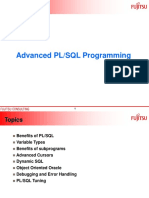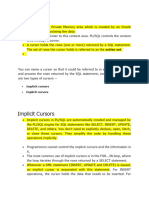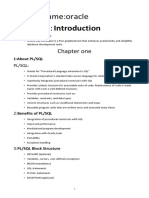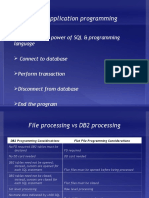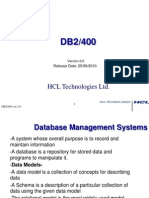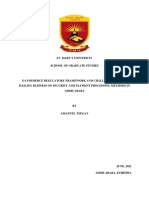Native Dynamic SQL
Uploaded by
Anonymous 7r2OlOFVNative Dynamic SQL
Uploaded by
Anonymous 7r2OlOFVNative Dynamic SQL
Native Dynamic SQL is create general purpose procedures and to execute DDL
commands within PLSQL
Use Native Dynamic SQL to create SQL commands that are built at run time
rather than at Program creation time.
Dynamic SQL can be used within stored procedural objects (such as Packages)
and in anonymous block.
EXECUTE_IMMEDIATE , OPEN FOR statements are used in dynamic SQL.
Note: if DDL commands are used through Dynamic SQL then , CREATE TABLE
system privilege must be explicitly granted.
1 10G PL/SQL
Examples
Create or replace anystring(string IN varchar2) as
Begin
Execute_immediate(string);
End;
execute anystring(create table emp(name varchar2 , age number(3), salary
number(20)));
2 10G PL/SQL
Using USING clause
USING clause is used along with EXECUTE IMMEDIATE statement
to pass parameter as Bind variable.
Example:
Declare
Symbol varchar(4) := WOND;
Begin
Execute immediate delete from stock where symbol = :symbol
Using Symbol;
End;
3 10G PL/SQL
Using RETURNING INTO clause
RETURNING INTO clause allows us to return column values for rows
affected by DML statements.
Example:
Declare
Emp_id number := 1001;
Salary_Bonus_percent number := 10;
New_salary number;
Begin
Execute immediate Update emp set salary = salary + (salary*
: Salary_Bonus_percent ) where emp_id = :emp_id returning salary into
:New_salary
using Salary_Bonus_percent , emp_id
Returning into New_salary;
End;
4 10G PL/SQL
Using DBMS_SQL
Prior to Oracle 9i , Dynamic SQL required the use of DBMS_SQL package
which gives greated control over the processing flow with in the
Dynamic SQL, but it is generally more complicated to write than the
native dynamic SQL.
Create or replace procedure anystring(string IN varchar2) is
Begin
Cursor_name integer;
Ret integer;
Cursor_name := DBMS_SQL.open_cursor;
DBMS_SQL.parse(cursor_name , string,DBMS_SQL.Native);
Ret := DBMS_SQL.execute(cursor_name);
DBMS_SQL.close_cursor(cursor_name);
End;
5 10G PL/SQL
Using DBMS_SQL
Execute anystring (drop table CD);
Execute anystring(create table CD (Artist varchar2(25).Title varchar2(25));
Execute anystring(Insert into CD values (MLTR,Sleeping Child));
Using BIND_VARIABLE and BIND_ARRAY procedures:
This procedures are used in passing parameter as Bind variables to dynamic sql
statements.BIND_ARRAY is used to pass more than one parameter.
Usage:-
6 10G PL/SQL
Using DBMS_SQL
Usage:-
DBMS_SQL.Parse(cursor_name,delete from CD where Artist = :artist,DBMS_SQL.Native);
DBMS_SQL.BIND_VARIABLE(cursor_name,:artist,artist_name);
Where artist_name is a parameter which is already declared or passed from calling
environment.
Use BIND_ARRAY To pass more than one parameter.
Usage:-
Declare
cursor_name Integer := dbms_sql.open_cursor;
Ret Integer;
emp_num dbms_sql.number_table;
emp_var dbms_sql.varchar2_table;
7 10G PL/SQL
Using DBMS_SQL
begin
dbms_sql.parse(cursor_name,'insert into emp(emp_id,emp_name) values ( :a, :b
)',dbms_sql.native );
emp_num(1) := 1001;
emp_num(2) := 1002;
emp_var(1) := 'John';
emp_var(2) := 'Naveen';
dbms_sql.bind_array(cursor_name, ':a', emp_num );
dbms_sql.bind_array(cursor_name, ':b', emp_var );
Ret := dbms_sql.execute(cursor_name);
dbms_sql.close_cursor(cursor_name);
end;
8 10G PL/SQL
Using DBMS_SQL
Using DEFINE_COLUMN function:
If your cursor performs a query, you must execute this function once for each column
being selected.Is it basically used to define the datatype and size of the variables that
will receive data from the Fetch_Rows() function
If the column defined with LONG datatype , then DEFINE_COLUMN_LONG must be
used.
Usage:-
.
DBMS_SQL.parse(cursor_name, select artist,title from CD, dbms_sql.native);
DBMS_SQL.DEFINE_COLUMN(cursor_name,1,artist,25);
DBMS_SQL.DEFINE_COLUMN(cursor_name,2,title,25);
.
9 10G PL/SQL
Using DBMS_SQL
Using FETCH_ROWS:
This function fetches a single row of data into the local buffer. This data can
then be stored in local variables by using the Column_Value() procedure.
Ret := DBMS_SQL.FETCH_ROWS(cursor_name);
Using COLUMN_VALUE:
This procedure stores the fetched single row of data into local variables.
DBMS_SQL.COLUMN_VALUE(cursor_name,1,artist);
DBMS_SQL.COLUMN_VALUE(cursor_name,2,title);
10 10G PL/SQL
Using DBMS_SQL
Using VARIABLE_VALUE:
BEGIN
cursor_name := dbms_sql.open_cursor;
dbms_sql.parse(cursor_name, 'INSERT INTO emp VALUES
(:empid,:salary,:bonus_percent) ' ||
'returning salary+(salary*bonus_percent) into :new_salary', dbms_sql.native);
dbms_sql.bind_variable(cursor_name, 'empid', v_empid);
dbms_sql.bind_variable(cursor_name, 'salary', v_salary);
dbms_sql.bind_variable(cursor_name, 'bonus_percent', v_bonus_percent);
dbms_sql.bind_variable(cursor_name, 'new_salary', v_new_salary);
n := dbms_sql.execute(c);
dbms_sql.variable_value(cursor_name, 'new_salary', v_new_salary); -- get value
of outbind
dbms_sql.close_cursor(c);
END;
11 10G PL/SQL
You might also like
- Examples : Execute Anystring ( Create Table Emp (Name Varchar2, Age Number (3), Salary Number (20) ) ')No ratings yetExamples : Execute Anystring ( Create Table Emp (Name Varchar2, Age Number (3), Salary Number (20) ) ')10 pages
- Using RETURNING INTO Clause: RETURNING INTO Clause Allows Us To Return Column Values For Rows Affected by DML StatementsNo ratings yetUsing RETURNING INTO Clause: RETURNING INTO Clause Allows Us To Return Column Values For Rows Affected by DML Statements8 pages
- Dynamic SQL in PL/SQL: Steven FeuersteinNo ratings yetDynamic SQL in PL/SQL: Steven Feuerstein34 pages
- Structure of PL/SQL: Baktagul Imasheva, Senior-Lecturer B.imasheva@iitu - KZNo ratings yetStructure of PL/SQL: Baktagul Imasheva, Senior-Lecturer B.imasheva@iitu - KZ49 pages
- Structure of PL/SQL: Baktagul Imasheva, Senior-Lecturer B.imasheva@iitu - KZNo ratings yetStructure of PL/SQL: Baktagul Imasheva, Senior-Lecturer B.imasheva@iitu - KZ49 pages
- Working With Composite Data Types: L/O/G/ONo ratings yetWorking With Composite Data Types: L/O/G/O67 pages
- PL SQL Les14 Packages Que Vienen Con OracleNo ratings yetPL SQL Les14 Packages Que Vienen Con Oracle42 pages
- Oracle SQL & PL/SQL Training: Click To Edit Master Subtitle StyleNo ratings yetOracle SQL & PL/SQL Training: Click To Edit Master Subtitle Style99 pages
- PL/SQL: By: Sonal Pandey M.E. CSE Dept. NITTTR ChandigarhNo ratings yetPL/SQL: By: Sonal Pandey M.E. CSE Dept. NITTTR Chandigarh42 pages
- LOB Datatypes: There Are Two Types of LOB'sNo ratings yetLOB Datatypes: There Are Two Types of LOB's29 pages
- Sequence: Prof. Jaimini N.Patel (SDJ International College)No ratings yetSequence: Prof. Jaimini N.Patel (SDJ International College)14 pages
- Subject Name:oracle Part: PLSQL:: Chapter OneNo ratings yetSubject Name:oracle Part: PLSQL:: Chapter One12 pages
- Advanced SAS Interview Questions You'll Most Likely Be AskedFrom EverandAdvanced SAS Interview Questions You'll Most Likely Be AskedNo ratings yet
- Java Programming Tutorial With Screen Shots & Many Code ExampleFrom EverandJava Programming Tutorial With Screen Shots & Many Code ExampleNo ratings yet
- Powerexchange For Sap Netweaver 8.6 Transport Versions Installation NoticeNo ratings yetPowerexchange For Sap Netweaver 8.6 Transport Versions Installation Notice3 pages
- DB2 Transparencies (Unit 3) : DB2 - TR Ver. 1.0.0 04/12/1998 Page 1 of 54No ratings yetDB2 Transparencies (Unit 3) : DB2 - TR Ver. 1.0.0 04/12/1998 Page 1 of 5454 pages
- Daily Updation Sheet- Bridge Works 27.12.2024No ratings yetDaily Updation Sheet- Bridge Works 27.12.20242 pages
- 48TMSS07R0 Active - Passive Shelters For Telecommunication FacilitiesNo ratings yet48TMSS07R0 Active - Passive Shelters For Telecommunication Facilities15 pages
- III. 2. Approaches To Leadership, Leadership in Buisness (Styles) ReadyNo ratings yetIII. 2. Approaches To Leadership, Leadership in Buisness (Styles) Ready29 pages
- (123doc) Bai Tap Mon Tieng Anh Kinh Te Quoc Te Reply and QuotationNo ratings yet(123doc) Bai Tap Mon Tieng Anh Kinh Te Quoc Te Reply and Quotation6 pages
- rrb gbo 2024 123_229b1006-6c96-4bbd-a90e-b4184d2ba122No ratings yetrrb gbo 2024 123_229b1006-6c96-4bbd-a90e-b4184d2ba12227 pages
- Shop Safety Rules and Practices Tve 7 ModuleNo ratings yetShop Safety Rules and Practices Tve 7 Module13 pages
- Chapter I. Overview: Generator User'S ManualNo ratings yetChapter I. Overview: Generator User'S Manual10 pages
- Lecture 1 - Def-Characteristics-Evolution of EntrepNo ratings yetLecture 1 - Def-Characteristics-Evolution of Entrep59 pages






